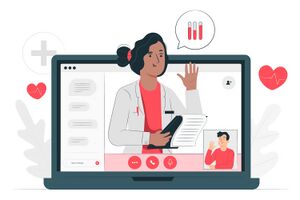Digital Health Literacy: Difference between revisions
(edit dhl in patients) |
mNo edit summary |
||
| Line 9: | Line 9: | ||
== DHL in patient groups == | == DHL in patient groups == | ||
DHL is an important determinant of digital health equity | DHL is an important determinant of digital health equity. <ref name=":1" /> In order to ensure that patients, and vulnerable groups, benefit from digital services, the following challenges should be addressed: | ||
* '''Digital literacy issues''' due to lack of access and ability to use digital technology | * '''Digital literacy issues''' due to lack of access and ability to use digital technology | ||
Revision as of 10:00, 26 December 2022
Original Editor - Angeliki Chorti Top Contributors - Angeliki Chorti, Kim Jackson and Rujuta Naik
Digital Health Literacy[edit | edit source]
Digital Health Literacy (DHL) or e-Health Literacy refers to the degree to which individuals have the ability to find, understand and use information and services from electronic sources in order to make health decisions and take appropriate actions. [2]
DHL seems to relate to Health Literacy (HL), the ability to deal with information in a manner that promotes health decisions. Del Giudice et al. [3] suggest that studying or working in the health field leads to a higher functional HL level and this correlates to a greater DHL score. However, research has indicated that DHL and HL should not be used interchangeably. [4] One possible reason for this may be the fact that the skills required for these two constructs are different and unique. [4]
DHL in the health professions[edit | edit source]
Digital technologies are lately becoming more common due to their potential to improve healthcare delivery and outcomes. Despite the suggested importance of e-Health, the use of digital solutions by health professionals and students is not yet fully satisfactory. [5] [6] Physiotherapists are also cautious about implementing digital change; among the reasons for the low level of adoption of e-Health tools are lack of familiarity with implemented tools and inadequate training and support. [7] [8] The inclusion of e-Health in physical therapy education is often hindered by negative attitudes towards e-Health which are often driven by a related lack of quality and evidence of an ill-defined concept with unclear ways to use. [9]
DHL in patient groups[edit | edit source]
DHL is an important determinant of digital health equity. [10] In order to ensure that patients, and vulnerable groups, benefit from digital services, the following challenges should be addressed:
- Digital literacy issues due to lack of access and ability to use digital technology
- Security issues arising from concerns on confidentiality and lack of trust when using digital platforms
- Practical issues due to space, accoustic and language barriers
- Lack of human connection and misunderstandings in situations where face-to-face interactions and non-verbal communication cannot be replaced
- Lack of awareness on what is available and of value
Promoting DHL in health[edit | edit source]
Resources[edit | edit source]
European citizens' digital health literacy report
Digital health literacy in general populations - an international comparison
References[edit | edit source]
- ↑ Image by: <a href="https://www.freepik.com/free-vector/online-doctor-concept-illustration_7709378.htm#query=digital%20health&position=12&from_view=search&track=sph">Image by storyset</a> on Freepik [accessed 20-12-2022]
- ↑ Norman C., Skinner H. eHealth Literacy: Essential Skills for Consumer Health in a Networked World. J Med Internet Res. 2006 Jun 16;8(2):e9. doi: 10.2196/jmir.8.2.e9.
- ↑ Del Giudice P., Bravo G., Poletto M., De Odorico A., Conte A., Brunelli L., Arnoldo L., Brusaferro S. Correlation Between eHealth Literacy and Health Literacy Using the eHealth Literacy Scale and Real-Life Experiences in the Health Sector as a Proxy Measure of Functional Health Literacy: Cross-Sectional Web-Based Survey. J Med Internet Res. 2018 Oct 31;20(10):e281.
- ↑ 4.0 4.1 Monkman H., Kushniruk A., Barnett J., Borycki E., Greiner L., Sheets D. Are Health Literacy and eHealth Literacy the Same or Different? Stud Health Technol Inform. 2017;245:178-182.
- ↑ Kuek A., Hakkennes S. Healthcare staff digital literacy levels and their attitudes towards information systems. Health Informatics Journal 2020; 26(1):592-612.
- ↑ Nationwide Assessment of Knowledge and Perception in Reinforcing Telemedicine in the Age of COVID-19 Among Medical Students From Pakistan. Front Public Health 2022; 10: 845415.
- ↑ Postolache G., Oliveira R., Postolache O. Contextual Design of ICT for Physiotherapy: Toward Knowledge and Innovation Ecosystem. EAI Endorsed Transactions on Creative Technologies;17(13):e3.
- ↑ Blumenthal J., Wilkinson A., Chignell M. Physiotherapists’ and physiotherapy students’ perspectives on the use of mobile or wearable technology in their practice. Physiotherapy Canada 2018; 70: 251–261.
- ↑ Wentink M., Siemonsma P., van Bodegom-vos L., de Kloet A., Verhoef J., Vlieland T., Meesters J. Teachers’ and students' perceptions on barriers and facilitators for eHealth education in the curriculum of functional exercise and physical therapy: a focus groups study. BMC Med Educ. 2019; 19:1–8.
- ↑ 10.0 10.1 Kaihlanen A-M., Virtanen L., Buchert U., Safarov N., Valkonen P., Hietapakka L., Hörhammer I., Kujala S., Kouvonen A., Heponiemi T. Towards digital health equity - a qualitative study of the challenges experienced by vulnerable groups in using digital health services in the COVID-19 era. BMC Health Services Research 2022; 22:188.







